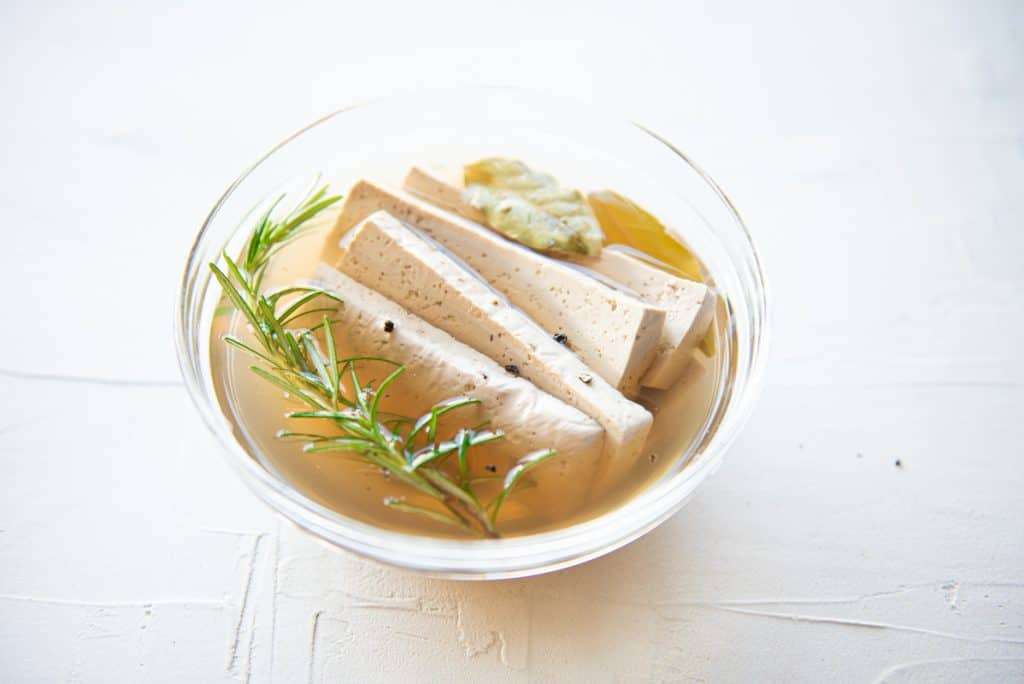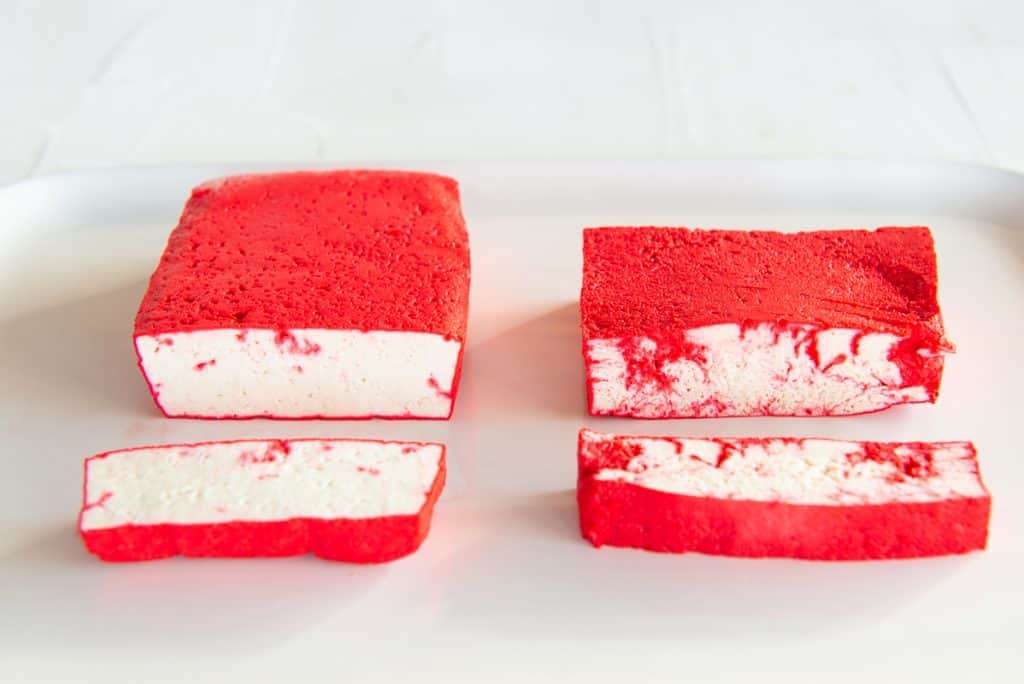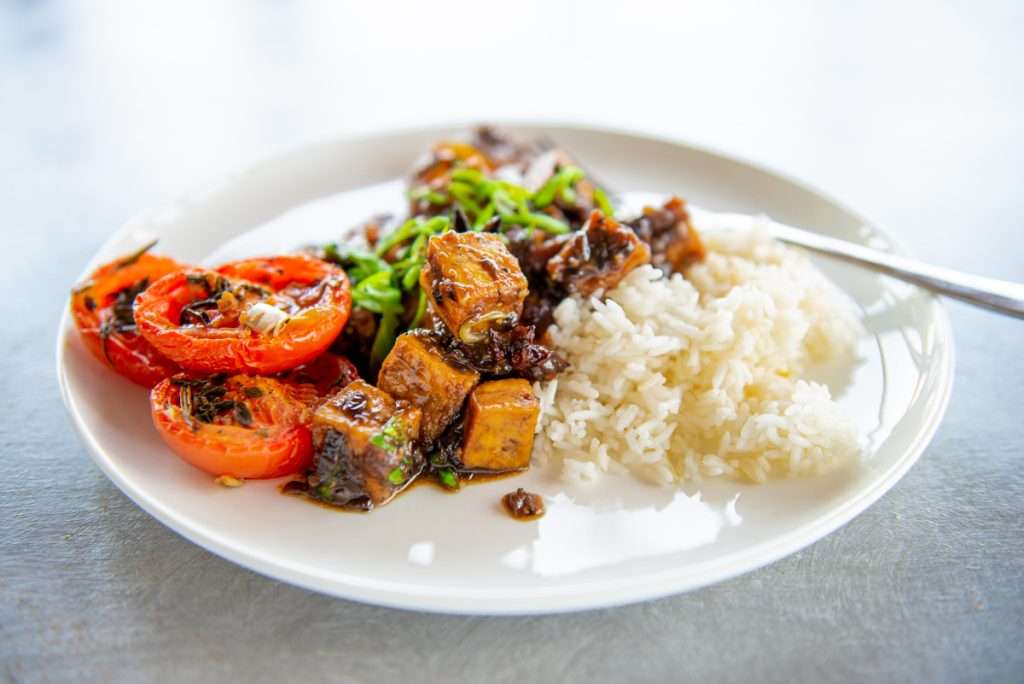
How to make tofu tasty? About marinating tofu, pressing it, freezing it and more.
This article is about flavoring tofu, making tofu tasty and marinating tofu. We discuss the most effective methods and the best ingredients to make your tofu really tasty.
Tofu, you either love it or hate it. For people who want to switch to (more often) plant-based cooking and eating, tofu seems unavoidable. However, the newcomer often has to get used to the taste (or lack thereof) of tofu. Marinating tofu can help enormously. From a culinary point of view, the essence of tofu lies primarily in its special texture and the ability to combine with any flavour imaginable.
So, tofu feels just as happy in a sauce loaded with garlic, ginger and chilis as it does in a delicate vanilla cream with strawberries. But how do you make tofu really tasty? What are the best techniques for marinating tofu? How do you give it a full and deep flavour? How can you prepare tofu so delicious that even Uncle Leo, who loves steak, asks for an extra portion? That’s what this article is about.
What exactly is tofu?
Before we get to the taste, let’s have a quick look at what tofu actually is and what it is made of. The making of tofu can be compared to the making of cheese. The basis for both is milk, and in the case of tofu the milk is obtained from soya beans. Soak the soya beans, grind them, mix with water and sieve. And voilá, you have soya milk. This soya milk still needs to be cooked, because raw legumes contain a substance that we cannot digest properly, namely lectin. By heating, the lectin becomes inactive and we can eat it without any problems. Next, calcium sulphate (gypsum), magnesium chloride (bittersalt) or acid is added to the milk, causing the proteins in the milk to curdle and clot.
These clumping proteins are then scooped into a cloth and pressed together. This forms the actual tofu as you know it. By pressing the tofu harder and longer, you can obtain different types of tofu. Also the used coagulant influences the structure. With gypsum you obtain the somewhat rougher Chinese tofu, with bitter salt or acid the smooth silken tofu which is more common in Japan is obtained. The most common types are silken tofu, firm silken tofu, regular tofu, firm tofu (this is what you usually find in the supermarket) and extra-firm tofu.
Origin
The technique of making tofu is at least 2,000 years old and was first mentioned in Chinese manuscripts. Traditionally, tofu is found in the kitchens of China, Japan, Korea, Vietnam, Thailand, Indonesia, Malaysia, Cambodia, Myanmar and the Philippines. In 1878, the first Western factory for tofu production was put into operation in the USA. It was not until the middle of the 20th century that tofu started to become popular in the West, especially among vegetarian and vegan cuisine enthusiasts.
But what is the importance of this very short history lesson anyway? Well, If you want to unlock the culinary secrets of an ingredient, it is a wise move to look at how this product is used in the kitchens of the regions where it comes from. There, they have been experimenting with that particular ingredient for hundreds or thousands of years. This is where they have found, by trial and error, some optimal and tasty preparations. And when we talk about tofu, we are talking about the Asian cuisines mentioned earlier.
Techniques
Marinating tofu
When marinating your tofu with a marinade, the flavours penetrate below the surface of the tofu. This way, you do not only have flavour on the outside, but also on the inside, which is extra tasty. When marinating, in addition to flavourings, you usually also dissolve salt. We call this a wet marinade. This recipe for a tasty wet marinade is versatile in preparing your recipes with tofu.
Unfortunately, the actual penetration of a marinade into tofu is rather disappointing. But luckily, there are various methods of improving the absorption capacity of tofu during marinating. We discuss them in the following paragraphs.
Preparation for marinating tofu: cooking or steaming
Cooking or steaming tofu is a technique to make the tofu firmer and to allow it to absorb a marinade optimally. Cut the tofu into slices or cubes and boil (in lightly salted water) or steam the tofu for a few minutes. Then lay the tofu on a cloth or kitchen paper and squeeze out as much moisture as possible. Now put the still hot tofu into a marinade as quickly as possible. The hot and pressed tofu will now absorb the marinade extra well. You can then prepare the tofu further by baking, deep-frying, grilling or stewing it in a sauce.
Preparation for marinating tofu: pressing
The pressing of tofu is intended to get rid of moisture from the tofu. This technique can be used in preparation for marinating the tofu. The hollows in the tofu that used to contain water can be filled with the marinade after pressing. Another function of pressing tofu is to be able to fry it crispy. How is it done? Wrap a clean kitchen towel around the block of tofu or wrap it in a few layers of kitchen paper. Place the block of tofu between two cutting boards and place a weight (approx. 1 kg) on the top cutting board. Leave the tofu to stand for an hour.
If you want to do this more often, it’s worth buying a tofu press. With a tofu press, you can vary the pressure and it is a lot more stable. The cutting-board-and-weight method tends to sometimes fall over spontaneously during pressing. If you want to press your tofu to the next level, you can freeze and defrost the tofu before pressing it. The next paragraph is about how and why to do that.
Preparation for marinating tofu: freezing and double freezing
Freezing and thawing the tofu is a method of increasing the absorption of marinade or sauce flavours. It also helps to make the tofu firmer, spongier and drier, allowing for crispy frying. Double freezing and defrosting further enhances the effect of drying. After freezing and defrosting, squeeze the tofu to get rid of as much moisture as possible. You can freeze a whole block at once, but this will take quite some time to defrost. Alternatively, you can slice the tofu in thick slices. Put the slices in airtight containers and stash it in the freezer.
In the photo below, you can clearly see the effect of freezing and squeezing. We put the two blocks of tofu in a colored solution for an hour to see the effect clearly. After marinating, we cut both blocks to see how far the marinade had penetrated. The picture clearly shows that in the frozen and defrosted tofu (the right block), the marinade penetrated further, and also more marinade penetrated. This experiment proves that freezing, thawing and pressing is a very effective technique for adding flavor to your tofu.

A little layer of flavor: Coating or glazing
Another method of giving your tofu more flavour is by coating it with a thin layer of flavour on the outside. In that case, you can skip the whole freezing, thawing and pressing thing. This method keeps the tofu soft and juicy on the inside.
How to proceed?
Cut the tofu into cubes or slices and pat dry. Then sprinkle the tofu with potato starch, cornstarch or rice flour and mix well so that all sides are covered. Now fry the tofu in a deep fryer, wok or frying pan with a generous amount of oil until it is golden brown. This also works very well in the air fryer or convection oven: sprinkle the starch-coated tofu with one tablespoon of oil per 300 g of tofu and bake in the air fryer for 6 – 10 minutes or in the oven for 15 minutes at 180° C. Shake the tofu out once in between. Drain the tofu on kitchen paper and then add the fried tofu to the sauce. This should be a thin, and real tasty sauce.
What happens next is that the starch layer, which has attached itself to the tofu through frying, sucks up the sauce. In this way, the sauce adheres well to the tofu, increasing the binding of the sauce. This technique works very well with a thin soy sauce, thin tomato sauce or curry. Before serving, leave the tofu to simmer gently in the sauce for approx. 5 – 10 minutes. The recipe for Spicy tofu with cinnamon, orange and star anise is based on this method. The picture below shows clearly see how the sauce forms a tasty coating on the tofu.

Breading
Is there anything that is as irresistibly delicious as food wrapped in a golden brown and crispy crust? Tofu is excellent when breaded, especially if you season it beforehand, for example with a wet marinade or dry rub of spices. Make a thin batter from flour, water, a pinch of baking powder and salt. Now run the tofu through the batter and roll the tofu in breadcrumbs. They’re now ready to be fried until crispy and golden in the frying pan or in the deep fryer. For an extra good result, use panko, Japanese breadcrumbs. Pro-tip if you want to airfry these crispy tofu nuggets: roast the breadcrumbs golden in your oven or airfryer before breading. The breadcrumbs do not or hardly colour when you fry the nuggets in the airfryer.
Smoking tofu
Smoking tofu is relatively simple, and produces a very distinctive and full flavour. By using smoked tofu in a dish, the tofu now suddenly acts as a flavour-giving ingredient in your dish. You can use smoked tofu as a substitute in certain traditional dishes that use smoked meat (for example in a stew, cassoulet or mash), or to add a new, fuller flavour to dishes that use tofu. This recipe for smokey tofu ribs with tomato salsa owes much of its rich flavour to the smoky aroma of the tofu.
How does it work?
First you will need a stove top smoker and some wood chips or sawdust. You can also improvise a stove top smoker with a pan, we’ll explain this below. Now take a block of firm tofu. You can either smoke the tofu as a block or in thick slices. For extra flavour, first marinate the tofu for 2 hours with the wet brine marinade from the section on marinating, and then smoke the tofu for 10 minutes in a special smoking oven or in an improvised smoking oven made from a sealable pan see below). Sprinkle smoke dust on the bottom of the smoker, put the drip tray with grid over it and put the block of tofu (or the slices) on the grid. Put the oven on medium heat so that the sawdust starts to smoulder and let it smoke for 10 minutes. Remove the oven from the fire and leave the tofu to stand for another 15 minutes. Your smoked tofu is now ready for use.
Instead of a smoker, you can also use a sealable pan: put a piece of aluminium foil on the bottom of the pan and sprinkle the sawdust on it, then place a sieve in the pan and put the tofu in it. Put the lid on the pan and close the edges with a wet cloth or aluminium foil. Put the pan on the heat and your homemade smoker is up and running. Would you like to experiment a bit with the smoke flavoring? It is also possible to smoke with tea, rice or spices. In this recipe for Smoked Tofu with Radish Salsa rice garam masala, tea and sugar are used instead of wood chips or sawdust. Isn’t that cool?
Intense flavouring
If you use intense flavours in your recipes with tofu, you need to make less effort to add flavour to the tofu itself. Examples of this method can be found mainly in various Asian cuisines. Think for example of Chinese, Indonesian and Japanese dishes with soy sauce, garlic, ginger and chillies or of spicy Thai curries. In the recipe for Spicy Silken Tofu below, the tofu is simply topped with a rich sauce made from soy sauce, roasted peanuts, garlic and red pepper paste and finished off with crispy ginger strips, lime leaves and coriander. You then spoon the tofu with the sauce. A delicious appetiser or snack: tasty, nutritious and healthy. The special structure of the silken tofu and the deliciously deep flavours of the sauce make this dish a culinary feast. Watch the video & instructions for this delicious recipe below.

Further reading?
Are you a (aspiring) tofu afficionado and do you want to continue reading after all this? For instance about the origin of tofu, or about all the different types of tofu that exist? The wikipedia page on tofu is extensive and contains excellent information and references. Mary’s testkitchen is an interesting vegan food blog where you can find great videos about making your own tofu.



